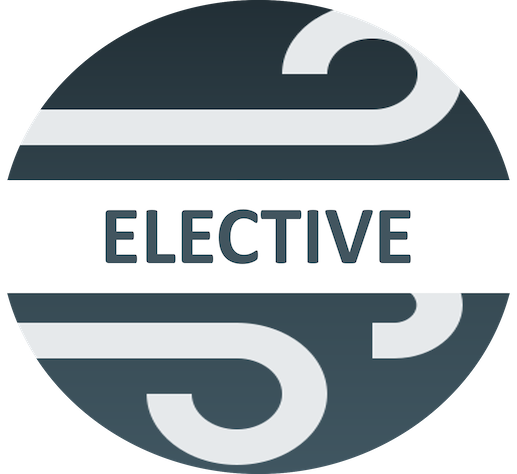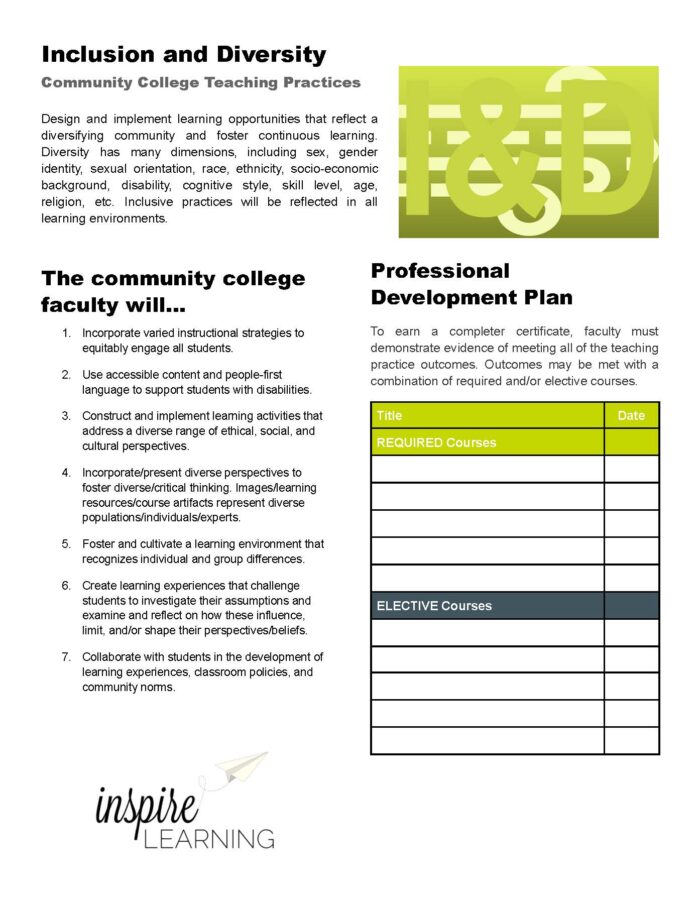Inclusion and Diversity
Design and implement learning opportunities that reflect a diversifying community and foster continuous learning. Diversity has many dimensions, including sex, gender identity, sexual orientation, race, ethnicity, socio-economic background, disability, cognitive style, skill level, age, religion, etc. Inclusive practices will be reflected in all learning environments.
The community college faculty will…
- Incorporate varied instructional strategies to equitably engage all students.
- Use accessible content and people-first language to support students with disabilities.
- Construct and implement learning activities that address a diverse range of ethical, social, and cultural perspectives.
- Incorporate/present diverse perspectives to foster diverse/critical thinking. Images/learning resources/course artifacts represent diverse populations/individuals/experts.
- Foster and cultivate a learning environment that recognizes individual and group differences.
- Create learning experiences that challenge students to investigate their assumptions and examine and reflect on how these influence, limit, and/or shape their perspectives/beliefs.
- Collaborate with students in the development of learning experiences, classroom policies, and community norms.
Professional Development
To earn a completer certificate, faculty must demonstrate evidence of meeting all of the teaching practice outcomes. Outcomes may be met with a combination of required and/or elective courses. Access the CTL calendar to explore upcoming sessions.

Community Immersion
This workshop experience was designed to help MCC employees gain a better understanding of themselves as employees in a diverse community, gain a better understanding of the community including its challenges and resources, and develop a deep understanding of the experiences of the students and families with whom they will work. During the session, Deanna Villanueva-Saucedo will take us on a pre-recorded tour of the community that envelops the MCC Southern & Dobson campus. The session facilitator will share resources to explore and discuss the community’s diverse historical roots, the varied socioeconomic and ethnic populations, and issues of racialization, segregation, and marginalization of some areas within the community. Outcome 6

Improving Course Accessibility
Accessibility supports inclusion for people with disabilities and benefits people without disabilities. In this session, practice techniques to remediate Word processing and Acrobat documents. Participants will apply accessibility techniques to Canvas and use the UDOIT tool to audit their courses. Outcome 2

Syllabus Reimagined: Student Capacity Mindset
During this session, we will explore a framework to create and present classroom policies with a capacity mindset to set a tone that all students can do the coursework with an appropriate level of support and encouragement. This session will also show district guidelines for syllabus content and tools available to more easily construct a syllabus. Outcomes 3, 5, 7

Cultural Wealth
This sessions offers resources and space for participants to make-meaning of culture and race. Perception differences are resolved by reaching consensus and dialogue. We explore the community cultural wealth model to identify opportunities to elevate cultural strengths for teaching and learning. Outcomes 5-6

Equity Online: Designing with Equity Online
Most institutions value diversity, equity, and inclusion but often struggle to help realize how to implement it into practice, especially in the classroom. The Peralta Equity Rubric is a research-based course design/redesign evaluation instrument designed to help faculty make the online course experience more equitable for all students. Join us in this two part session to learn about the rubric criteria and how to address equity online. Outcomes 1-7

Overcoming Stereotype Threat
Research suggests that when a student is in a performance situation with the potential to confirm negative stereotypes about the students identiy, possible outcomes include increased stress, reduction in working memory, and impaired performance or sense of belonging. Although stereotype threat is complex, we will explore ways to mitigate stereotype threat in the classroom. Outcome 6

A Critical Analysis of Diversity and Stereotyping in Text
In this session, we apply a critical perspective to analyze the diversity and stereotypes that exist in text. Participants will apply a single-point rubric to describe bias in publisher content and open education resources. We will identify and share resources that offer alternative perspectives to provided concepts. Outcomes 3, 5-6
Resources
- Banks and Banks (2007). Multicultural education: Issues and perspectives. Hoboken: Wiley
- Delpit, L. (2008). The Skin That We Speak: Thoughts on Language and Culture in the Classroom. The New Press.
- Dweck, C. (2019). Mindset: The New Psychology of Success. Random House.
- Freire, P. (1970). Pedagogy of the oppressed. New York, NY: Continuum.
- Gay, G. (2010). Culturally Responsive Teaching: Theory, Research and Practice (2nd ed.). (J. A. Banks, Ed.) New York, NY: Teachers College Press.
- Peralta Equity Rubric Team. (2020). The Peralta Equity Rubric. https://www.peralta.edu/distance-education/online-equity-rubric
- Schissler, H. & Soysal, Y. (Eds.) (2005). The nation, Europe, and the world. Textbooks and curricula in transition. New York/Oxford: Berghahn Books.
- Steele, C.M., Aronson J. “Stereotype threat and the intellectual test performance of African Americans”. Journal of Personality and Social Psychology. 1995; 69 (5): 797–811.
- Stingu, M. (2011). Reflexive practice in teacher education: Facts and trends. Procedia Social and Behavioral Sciences, 33, 617-621.
- Valencia College. (n.d.). Inclusion & Diversity. https://valenciacollege.edu/faculty/development/teaching-learning-academy/candidate/tla-inclusion-lcf.php
- Yosso, T.J. (2005). Whose culture has capital? Race, Ethnicity and Education, 8(1), pp. 69–91.

